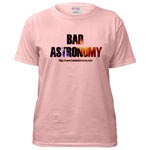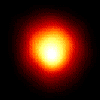
| Bad Astronomy |
|
|
|
BA Blog
|
|
Q & BA
|
|
Bulletin Board
|
| Media |
|
|
|
Bitesize Astronomy
|
|
Bad Astro Store
|
|
Mad Science
|
|
Fun Stuff
|
| Site Info |
|
|
|
Links
|
| RELATED SITES |
| - Universe Today |
| - APOD |
| - The Nine Planets |
| - Mystery Investigators |
| - Slacker Astronomy |
| - Skepticality |
Buy My Stuff

Keep Bad Astronomy close to your heart, and help make me
filthy rich. Hey, it's either this or one of those really
irritating PayPal donation buttons here.
Points of Light
Week of February 2, 1998
There was an interesting discussion recently on the USENET bulletin boards about the sizes of stars. When you look up in the sky all the stars look like little points, with no discernible disk (except for one, of course: the Sun). But this does not mean the stars are infinitely small points, just too small for the eye to resolve. Sometimes, though, it does look like the stars have some sort of width to them, but this is not because the stars are big, but instead because the Earth's atmosphere distorts the stars' images. Tiny cells of air in the Earth's atmosphere are constantly dancing about, and they act like tiny lenses, bending the stars' light. We see this dance as twinkling, which smears out the point of light from the star into a small disk. The more turbulent the atmosphere, the bigger the star looks.
There are ways around this. One, which seems kind of obvious now,
is to get a telescope above the Earth's atmosphere. We have done
this with the Hubble Space Telescope
and with many other telescopes as well. But this is terribly
expensive. Another method, used many years ago and still
producing excellent data today, is to take extremely short
exposures. This snapshot method freezes the turbulence
as far as the telescope is concerned, so the turbulence doesn't
affect the picture. This only works with very bright stars of course,
since a dim star won't show up well on such a short exposure.
but some of the brightest stars are also the biggest, so you
can use this method to see if they have disks. (I am grossly
oversimplifying the technique used, but if you'd like to know more
details, there are
plenty of websites about speckle interferometry).
 A similar method was used on board the Hubble Space Telescope to obtain
pictures of the red supergiant star Betelgeuse (most people pronounce
it "Beetle Juice", like the movie), easily visible in the winter skies
right now; the star marks the right shoulder of Orion. Click on
the picture to go to the Hubble site with a description of what the astronomers
did. Betelgeuse is an enormous star, so big that it would stretch
clear across the inner solar system if placed at the Sun's position. The
disk is clearly seen in this image, as well as a bright spot in its atmosphere
which is not well understood. Betelgeuse is many people's favorite candidate
for the Galaxy's next supernova. Good
thing it's so far away!
A similar method was used on board the Hubble Space Telescope to obtain
pictures of the red supergiant star Betelgeuse (most people pronounce
it "Beetle Juice", like the movie), easily visible in the winter skies
right now; the star marks the right shoulder of Orion. Click on
the picture to go to the Hubble site with a description of what the astronomers
did. Betelgeuse is an enormous star, so big that it would stretch
clear across the inner solar system if placed at the Sun's position. The
disk is clearly seen in this image, as well as a bright spot in its atmosphere
which is not well understood. Betelgeuse is many people's favorite candidate
for the Galaxy's next supernova. Good
thing it's so far away!
|
|
| THE PANTRY: ARCHIVE OF BITESIZE SNACKS |
|
|
| Subscribe to the Bad Astronomy Newsletter! |
| Talk about Bad Astronomy on the BA Bulletin Board! |